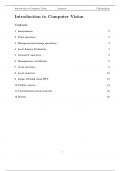Class notes
Summary Introduction to Computer Vision, Bachelor Computer Science & Artificial Intelligence UvA
- Course
- Institution
Complete summary of the contents for the exam for the course Introduction to Computer Science in the 2nd year of the Computer Science & Artificial Intelligence bachelor's degrees at the University of Amsterdam. The summary is in English, like the course. All lectures and lecture notes are in the s...
[Show more]



